How Scotland changed the face of British banknotes
- Published
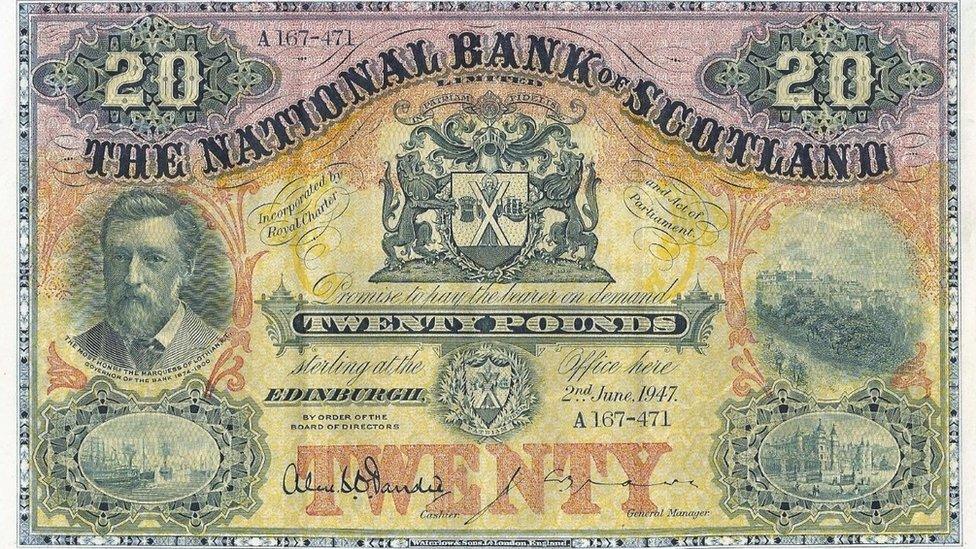
Scottish banks have produced some eye-catching notes
The Clydesdale Bank is set to continue issuing bank notes, despite the business being rebranded as Virgin Money.
We look back at some of the innovations by Scottish banks which have changed the face of cash down the centuries.
The face of innovation
Scotland's contribution stretches back to 1695, when the Bank of Scotland became the second successful bank in Europe (after the Bank of England a year earlier) to issue notes.
The bank enjoyed a monopoly in banking north of the border for 21 years. But it was Royal Bank of Scotland which was to prove the more innovative after its foundation in 1727.
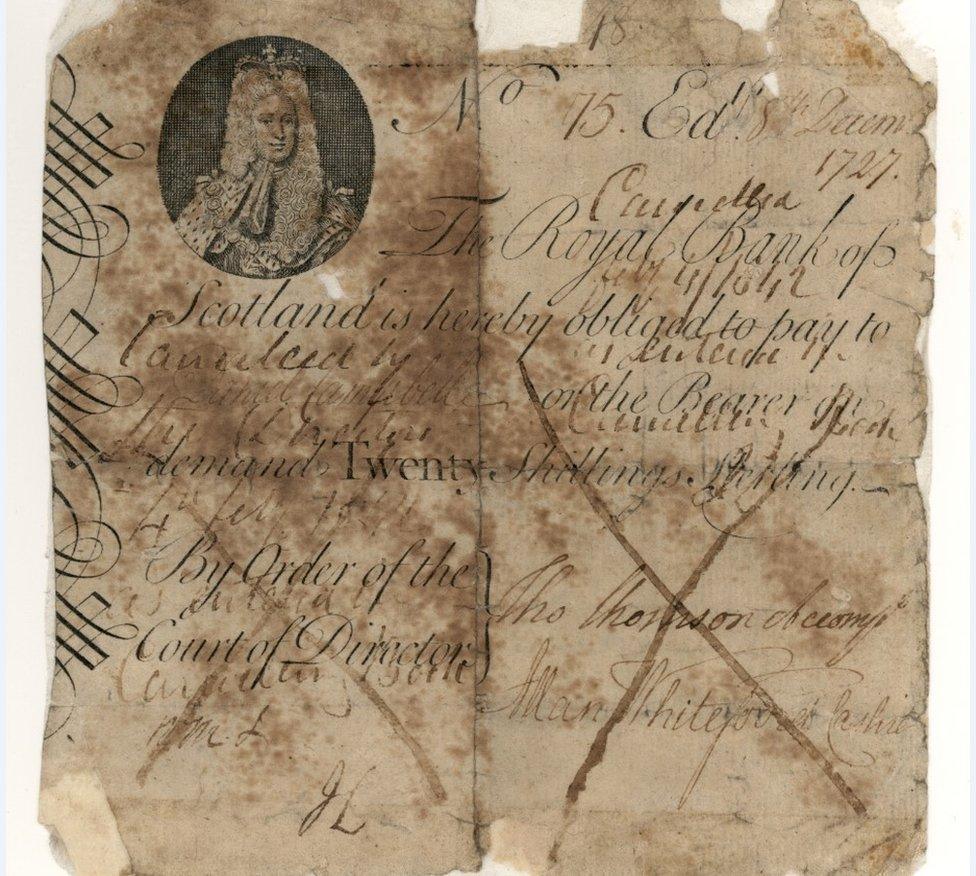
Royal Bank of Scotland was the first British bank to issue a note featuring a person's face
It wasted no time in issuing the first British note to make a main feature of a face.
The portrait belonged to the king at the time, George II.
Ruth Reed, head of archives at RBS, explains: "Nobody else had really done that before. Notes had had printed writing and some kind of design - squiggly lines and things.
"But by putting a portrait on, it was a very clever move for anti-forgery because humans are so good at distinguishing tiny little differences in faces."
Early banknotes
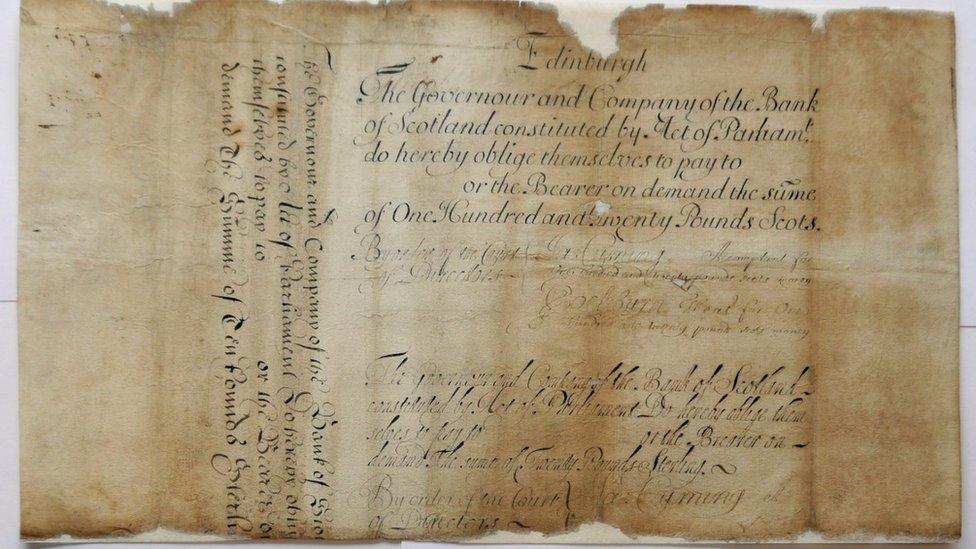
Paper Money of Scotland co-author Dave Murphy found this unissued fragment of a Bank of Scotland note which may pre-date the Act of Union of 1707
Early notes were a far cry from the paper - or rather, polymer - currency that we know today.
They were bound in books rather like a modern cheque book, but without perforations - requiring the user to cut them out with a knife or scissors.
Notes of £5 and upwards were known colloquially as "horse blankets" because of their enormous size - they measured at least 9in x 5in.
The Committee of Scottish Bankers says early banknotes were a crucial part of the currency of Scotland and "competed vigorously" with coins in the 18th and early 19th centuries.
There were times, for example, when £1 notes were torn into halves and quarters and were accepted as the equivalent of 10 shillings (50p) or 5 shillings (25p) in coin.
The start of colour
Nearly half a century later, Bank of Scotland became one of the first banks in Europe to issue a note in two colours. The blue and black one guinea note was released in 1774.
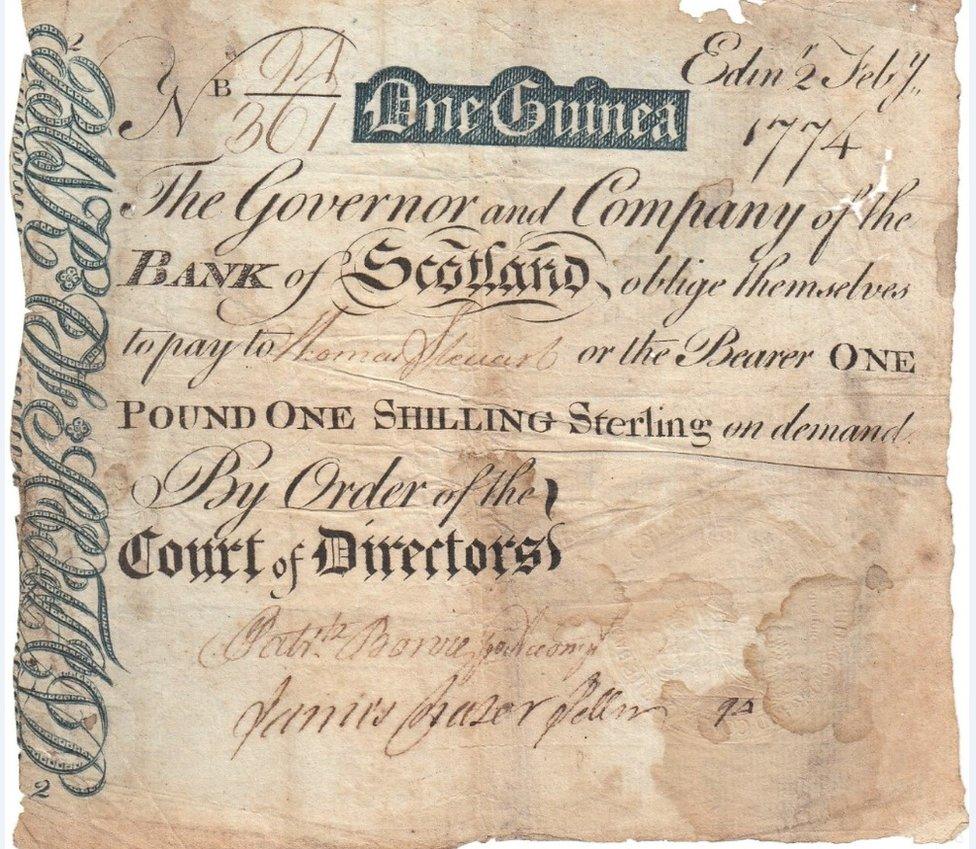
The Bank of Scotland issued the first note with two colours in 1774
According to Jonathan Callaway, co-author with Dave Murphy of Paper Money of Scotland, the innovation proved challenging at the time.
He explains: "In order to produce more than one colour, you had to engrave two plates, one for each of the colours of ink that you were using.
"Then you had to run the same piece of paper through two printing presses in order to get the black and the blue ink. It also had to be correctly lined up - what they call the registration.
"That was technically quite difficult at that time, which is why there are so few of these coloured notes still around."

Royal Bank issued the world's first three-coloured note in 1777
Three years later, the Royal Bank stole a march on its Scottish rival by issuing the world's first three-coloured note. It was engraved by Andrew Bell, one of the original founders of the Encyclopaedia Britannica, and ran from 1777 through to 1792.
Commemorative notes
There are other innovations on banknotes that can be traced back to Scottish banks.
In 1822, the Leith Bank produced the world's first commemorative issue, marking the visit of George IV to Edinburgh on 15 August of that year as he arrived by boat at Leith Harbour.
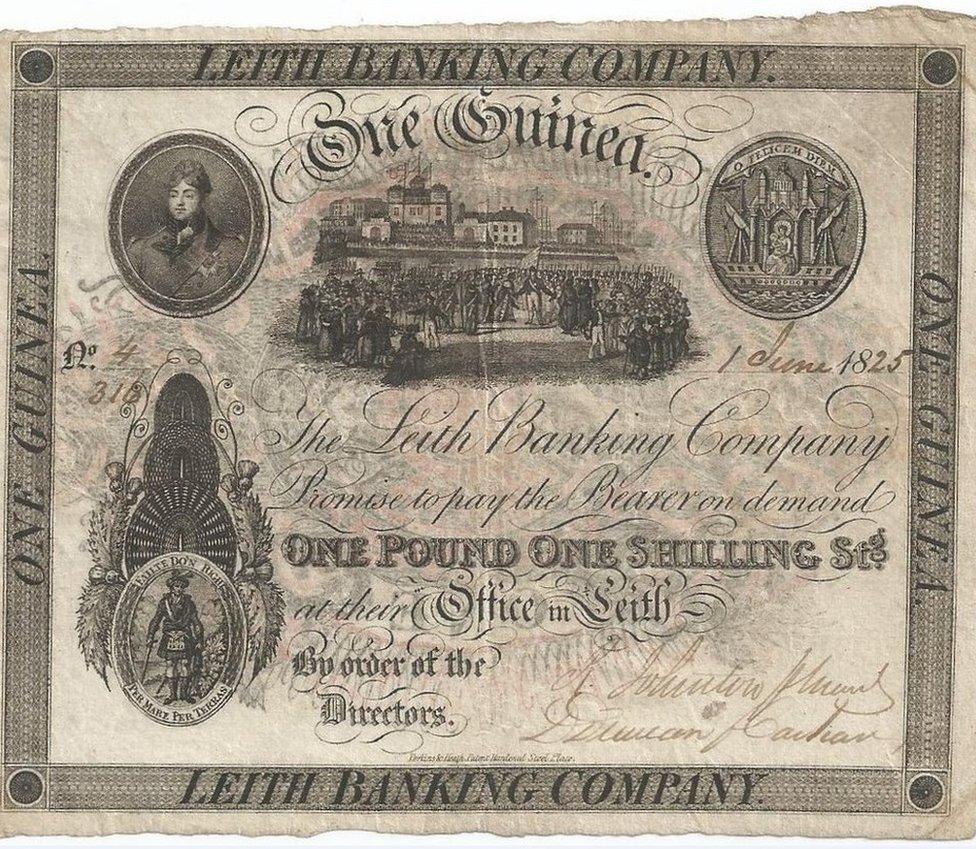
The Leith Bank produced a commemorative note marking a visit to Edinburgh by George IV in 1822
Mr Callaway explains: "As Leith had its own bank, they felt they had to commemorate that.
"In fact, the notes that were created for that occasion have vignettes showing pictures of the harbour with the royal barge being rowed in with him on it.
"There's also a vignette on one of the notes which has him standing on the quay surrounded by the welcoming army and marching band."

Commemorative notes failed to catch on and relatively few were initially produced by British banks.
However, RBS was to revive the practice in the modern era by issuing a note in 1992 to commemorate the European Council Summit held in Edinburgh that year.
Printed on both sides
If you've ever wondered why there are two sides to every banknote, look no further than the Royal Bank for the answer.
In 1826, it notched up a British first by creating a design on the back as well as the front of a £1 note.
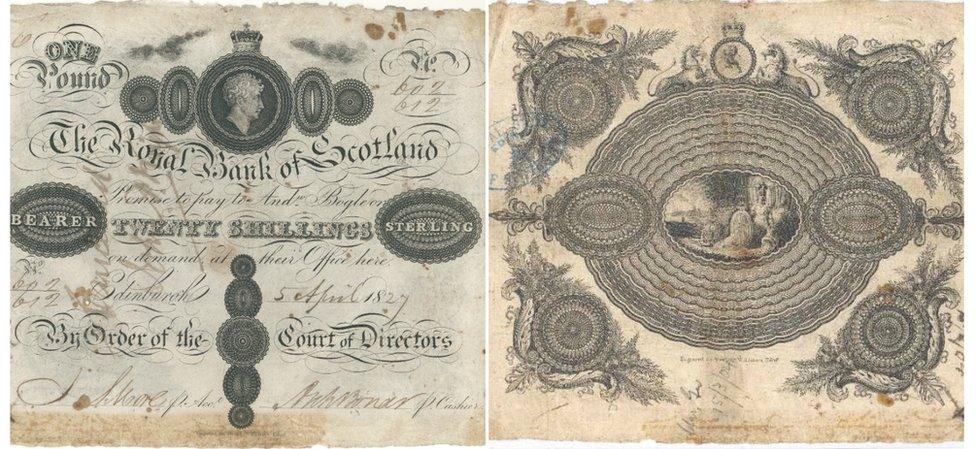
This Royal Bank note from 1827 was engraved by WH Lizars
Ruth Reed explains: "Unlike some other note-issuers at the time, the Scottish note-issuers didn't have to have a duty stamp on the back.
"So a lot of English notes had to have a space on the back for this big duty stamp.
"But with a different legal status for Scottish ones, they were able to introduce this very intricate machine-work design on the back."
That particular note did not last long, but the idea eventually caught on - even though uniface notes were still being issued as late as 1969.
Eye-catching designs
Note design was another area in which Scotland played a pioneering role.
Early on, Scottish banks hired some of Britain's most prestigious engravers to produce eye-catching notes.
They included William Home Lizars, a bookseller, publisher and engraver of plates for books.

William Home Lizars engraved a number of Scottish notes, including this Western Bank £20 note
From about 1815 onwards, Lizars engraved a series of high-quality notes for Bank of Scotland, Caledonian Bank, the Union Bank and the Western Bank, as well as many others.
Scottish banks went on to produce increasingly intricate - and beautiful - notes as time went on.
But despite a plethora of innovation in their earlier days, Scottish banks started to become more conservative in their approach.
For example, the Royal Bank kept more or less the same £1 note design from 1832 until the mid-1960s.
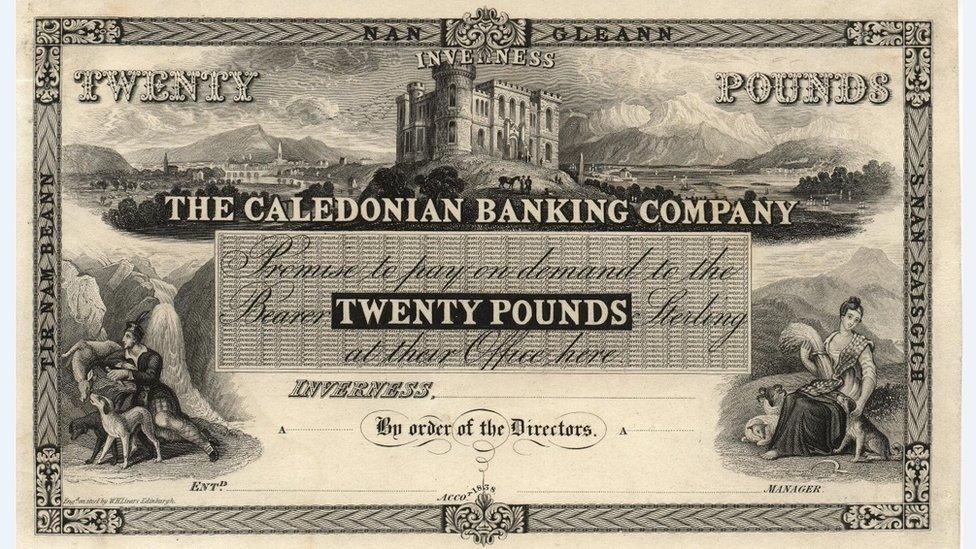
Lizars also engraved this Caledonian Bank note
Ms Reed explains: "It changed a bit and it changed shape, but you could really recognise it throughout that period.
"There were underlying changes happening for anti-forgery measures within those designs.
"For the banks it's probably been a constant battle between wanting to innovate but also wanting it to look like a proper banknote and honour the traditions of what's gone before and what people are expecting to see."
Signed by hand
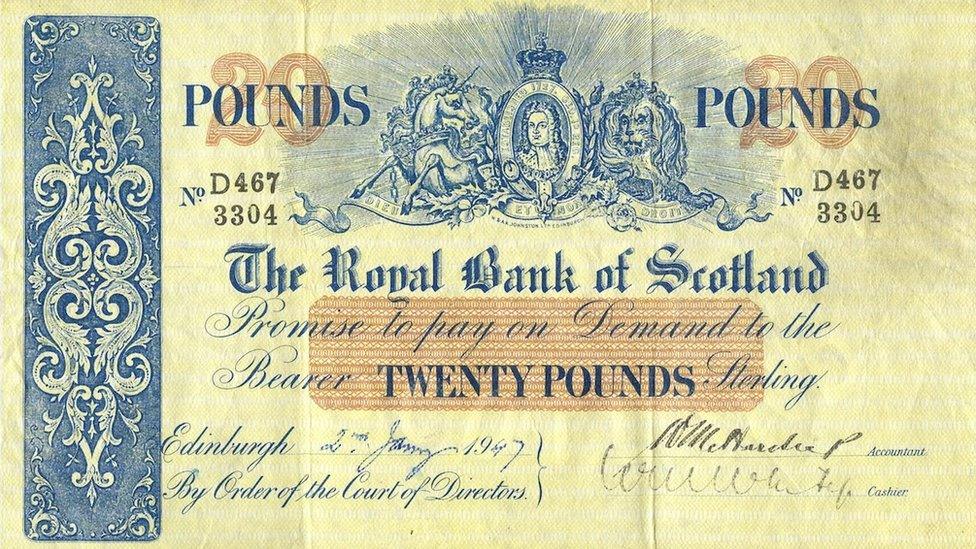
The last hand-signed Scottish note (a Royal Bank £20) was issued in 1947
Banks were also slow to end practices such as hand-written signatures on each individual note.
Mr Callaway says: "There were a lot of things that were done early on that were labour intensive that became less doable the more notes you were issuing. Hand-signing is one example."
The last hand-signed Scottish banknote was the RBS £20 issued in 1947.
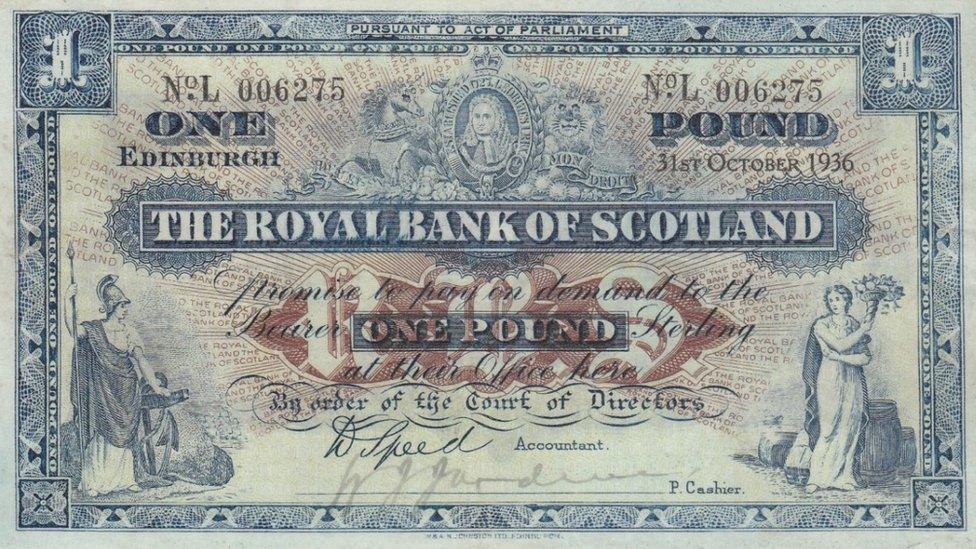
Nearly 10 million Royal Bank £1 notes were signed by hand between 1927 and 1936
The final hand-signed £1 note was also issued by RBS in 1936 - a series that had required nearly 10 million signatures since 1927.
Since then, notes have featured the printed signature which we recognise today.
Plastic notes

The Clydesdale £5 plastic note featured Scottish engineering pioneer Sir William Arrol
Scotland's most recent contribution to banknote history came in 2015, when the Clydesdale became the first bank in Great Britain (although not the UK) to issue a polymer note.
The move suggested that Scottish financial institutions are still banking on innovation when it comes to cash.
All images subject to copyright
- Published14 April 2019

- Published11 April 2019
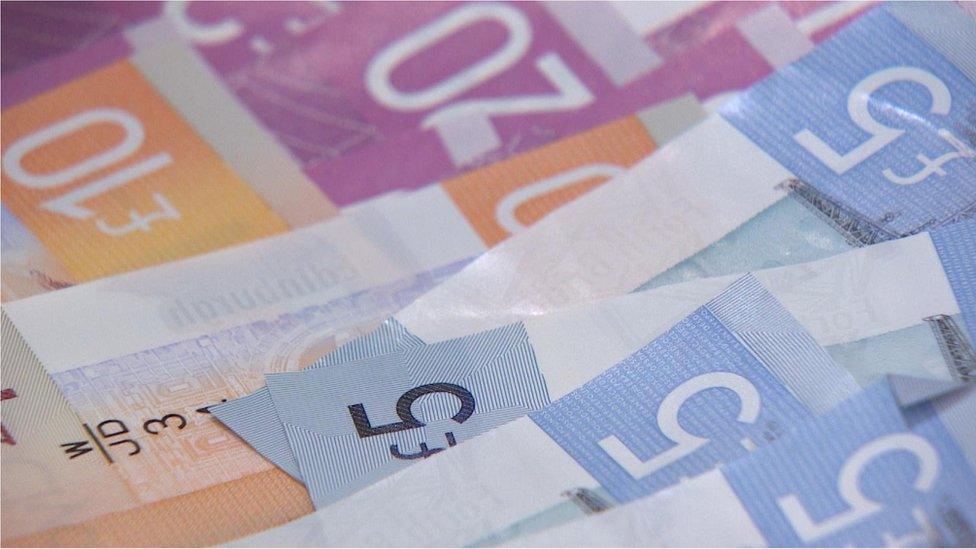
- Published23 March 2015
